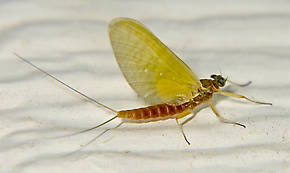Blog & Latest Updates
Fly Fishing Articles
Insects by Common Name


Pale Brown Duns
Scientific Names
| Match | Scientific Name |
| Rhithrogena hageni | |
| Cinygmula reticulata |
Like most common names, "Pale Brown Dun" can refer to more than one taxon. They're previewed below, along with 6 specimens. For more detail click through to the scientific names.
Mayfly Species Rhithrogena hageni
These are very rarely called Pale Brown Duns.
According to Fred Arbona in Mayflies, the Angler, and the Trout, this is an excellent hatch and one of the most common fast-water mayflies in the West.
Rhithrogena hageni (Western Black Quill) Mayfly Nymph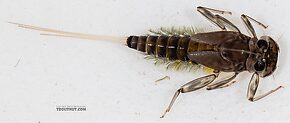 View 9 PicturesI'm basing the ID of this near-mature nymph on a male spinner with similar size and markings, collected on the same trip. There isn't a key to reliably identify the nymphs of most Rhithrogena species otherwise.
View 9 PicturesI'm basing the ID of this near-mature nymph on a male spinner with similar size and markings, collected on the same trip. There isn't a key to reliably identify the nymphs of most Rhithrogena species otherwise.
 View 9 PicturesI'm basing the ID of this near-mature nymph on a male spinner with similar size and markings, collected on the same trip. There isn't a key to reliably identify the nymphs of most Rhithrogena species otherwise.
View 9 PicturesI'm basing the ID of this near-mature nymph on a male spinner with similar size and markings, collected on the same trip. There isn't a key to reliably identify the nymphs of most Rhithrogena species otherwise.Female Rhithrogena hageni (Western Black Quill) Mayfly Dun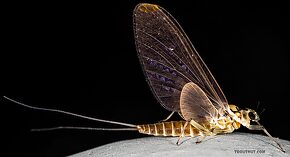 View 7 PicturesI was surprised by the olive cast on the body of this female Rhithrogena dun, which led me to mistake it for a western green drake (Drunella) in the field. I was pleasantly surprised to get a closer look and find something I hadn't collected yet. Its species ID is based on proximity to male spinner collected on the same trip, as well as physical similarity (size, tergite (
View 7 PicturesI was surprised by the olive cast on the body of this female Rhithrogena dun, which led me to mistake it for a western green drake (Drunella) in the field. I was pleasantly surprised to get a closer look and find something I hadn't collected yet. Its species ID is based on proximity to male spinner collected on the same trip, as well as physical similarity (size, tergite (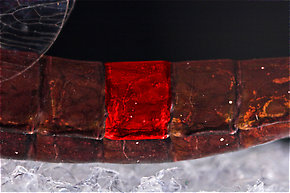 Tergite: The top (dorsal) part of a single segment on an insect's abdomen when it consists of a single chitinous plate (sclerite), or an individual sclerite if the segment has more than one.) coloration, dark streaks on the femora (
Tergite: The top (dorsal) part of a single segment on an insect's abdomen when it consists of a single chitinous plate (sclerite), or an individual sclerite if the segment has more than one.) coloration, dark streaks on the femora (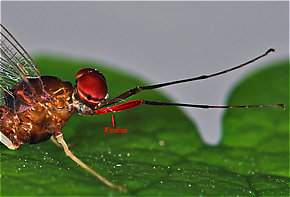 Femur: The main segment of an insect's leg close to the body, in between the tibia and the trochanter.)) to that specimen.
Femur: The main segment of an insect's leg close to the body, in between the tibia and the trochanter.)) to that specimen.
 View 7 PicturesI was surprised by the olive cast on the body of this female Rhithrogena dun, which led me to mistake it for a western green drake (Drunella) in the field. I was pleasantly surprised to get a closer look and find something I hadn't collected yet. Its species ID is based on proximity to male spinner collected on the same trip, as well as physical similarity (size, tergite (
View 7 PicturesI was surprised by the olive cast on the body of this female Rhithrogena dun, which led me to mistake it for a western green drake (Drunella) in the field. I was pleasantly surprised to get a closer look and find something I hadn't collected yet. Its species ID is based on proximity to male spinner collected on the same trip, as well as physical similarity (size, tergite (
One tergite of this Isonychia bicolor mayfly spinner is highlighted in red.

The femur of this Isonychia bicolor mayfly spinner is highlighted in red.
Male Rhithrogena hageni (Western Black Quill) Mayfly Spinner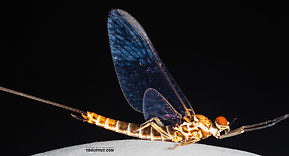 View 14 PicturesAlthough I could not find the preserved specimen to examine under my good new microscope, I'm tentatively calling it one Rhithrogena hageni, based on apparent similarity to this specimen, which I was able to positively ID.
View 14 PicturesAlthough I could not find the preserved specimen to examine under my good new microscope, I'm tentatively calling it one Rhithrogena hageni, based on apparent similarity to this specimen, which I was able to positively ID.
The relative angle of the penes (Penes: The paired genital structures of most male insects, which vary widely in form and are one of the main characteristics used for species identification.) is a bit shallower in this specimen, but I photographed another specimen from the same collecting trip (and I think even the same swarm, although I don't recall for sure) as the other one, and it had the shallower angle seen on this specimen. I'm guessing it's just variation within the species.
 View 14 PicturesAlthough I could not find the preserved specimen to examine under my good new microscope, I'm tentatively calling it one Rhithrogena hageni, based on apparent similarity to this specimen, which I was able to positively ID.
View 14 PicturesAlthough I could not find the preserved specimen to examine under my good new microscope, I'm tentatively calling it one Rhithrogena hageni, based on apparent similarity to this specimen, which I was able to positively ID. The relative angle of the penes (Penes: The paired genital structures of most male insects, which vary widely in form and are one of the main characteristics used for species identification.) is a bit shallower in this specimen, but I photographed another specimen from the same collecting trip (and I think even the same swarm, although I don't recall for sure) as the other one, and it had the shallower angle seen on this specimen. I'm guessing it's just variation within the species.
See 1 more specimens...
Mayfly Species Cinygmula reticulata
These are very rarely called Pale Brown Duns.
Cinygmula reticulata is probably the second most important species of Cinygmula behind Cinygmula ramaleyi, perhaps because the waters where it can be found in good numbers are often more remote. They have been reported as abundant in many high country streams of the Southern Rockies as well as the High Sierra's Eastern slope. An obvious difference in their coloration may be the easiest way to tell them apart. Cinygmula ramaleyi is more somber with a brownish body and dark gray wings and is often confused with the similar sized and colored Ephemerella tibialis, in spite of the difference in tail counts. Cinygmula reticulata on the other hand is a bright cinnamon dorsally with pale creamy legs and pale wings that are often a brilliant canary yellow. This is one of North America's most beautiful mayflies.
Cinygmula reticulata (Western Ginger Quill) Mayfly Nymph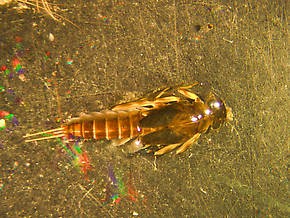 View 1 PicturesI collected several live specimens of nymphs and reared them to the imago (Imago: The sexually mature adult stage of the mayfly is called the imago by scientists and the spinner by anglers.) stage. They were C. reticulata. The interesting thing is they were collected in May and were emerging along with Rhithrogena (March Brown). This seems to be an overlooked hatch since in some rivers it emerges very early, before runoff.
View 1 PicturesI collected several live specimens of nymphs and reared them to the imago (Imago: The sexually mature adult stage of the mayfly is called the imago by scientists and the spinner by anglers.) stage. They were C. reticulata. The interesting thing is they were collected in May and were emerging along with Rhithrogena (March Brown). This seems to be an overlooked hatch since in some rivers it emerges very early, before runoff.
 View 1 PicturesI collected several live specimens of nymphs and reared them to the imago (Imago: The sexually mature adult stage of the mayfly is called the imago by scientists and the spinner by anglers.) stage. They were C. reticulata. The interesting thing is they were collected in May and were emerging along with Rhithrogena (March Brown). This seems to be an overlooked hatch since in some rivers it emerges very early, before runoff.
View 1 PicturesI collected several live specimens of nymphs and reared them to the imago (Imago: The sexually mature adult stage of the mayfly is called the imago by scientists and the spinner by anglers.) stage. They were C. reticulata. The interesting thing is they were collected in May and were emerging along with Rhithrogena (March Brown). This seems to be an overlooked hatch since in some rivers it emerges very early, before runoff.Male Cinygmula reticulata (Western Ginger Quill) Mayfly Spinner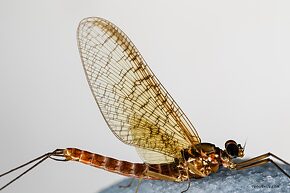 View 7 PicturesThe lengths of the wing and body, measured with a caliper, are both 8 mm.
View 7 PicturesThe lengths of the wing and body, measured with a caliper, are both 8 mm.
Keys in Needham's 1935 Biology of Mayflies point to either Cinygmula reticulata or Cinygmula gartrelli. IT seems to have “cross veins in costal half of fore wing only, slightly margined with brown” and “wings tinged withamber at base and along costal margin of both wings” (gartrelli) as opposed to “all cross veins of both wings faintly but broadly margined with pale smoky” and “wings entirely amber-tinged” (although there is a slight amber tinge throughout, just more pronounced in places) as in reticulata. However, wing length reported for reticulata (9 mm) is closer to this specimen than gartrelli (10 mm). Ventral (Ventral: Toward or on the bottom.) median marks are supposed to be “traces” for reticulata and “present” for gartrelli. Descriptions for both species involve semi-hyaline (Hyaline: Highly transparent, or glassy; usually refers to insect wings, especially those of mayfly spinners.) anterior (Anterior: Toward the front of an organism's body. The phrase "anterior to" means "in front of.") abdominal segments not present on my specimens. Distribution records suggest reticulate lives nearby, so I'm going with that, but I can't confidently rule out gartrelli.
 View 7 PicturesThe lengths of the wing and body, measured with a caliper, are both 8 mm.
View 7 PicturesThe lengths of the wing and body, measured with a caliper, are both 8 mm.Keys in Needham's 1935 Biology of Mayflies point to either Cinygmula reticulata or Cinygmula gartrelli. IT seems to have “cross veins in costal half of fore wing only, slightly margined with brown” and “wings tinged withamber at base and along costal margin of both wings” (gartrelli) as opposed to “all cross veins of both wings faintly but broadly margined with pale smoky” and “wings entirely amber-tinged” (although there is a slight amber tinge throughout, just more pronounced in places) as in reticulata. However, wing length reported for reticulata (9 mm) is closer to this specimen than gartrelli (10 mm). Ventral (Ventral: Toward or on the bottom.) median marks are supposed to be “traces” for reticulata and “present” for gartrelli. Descriptions for both species involve semi-hyaline (Hyaline: Highly transparent, or glassy; usually refers to insect wings, especially those of mayfly spinners.) anterior (Anterior: Toward the front of an organism's body. The phrase "anterior to" means "in front of.") abdominal segments not present on my specimens. Distribution records suggest reticulate lives nearby, so I'm going with that, but I can't confidently rule out gartrelli.
Top 10 Fly Hatches
Top Gift Shop Designs
Eat mayflies.
Top Insect Specimens
Miscellaneous Sites
Troutnut.com is copyright © 2004-2024 Jason
Neuswanger (email Jason). See my FAQ for information about use of my images.
 privacy policy
privacy policy

